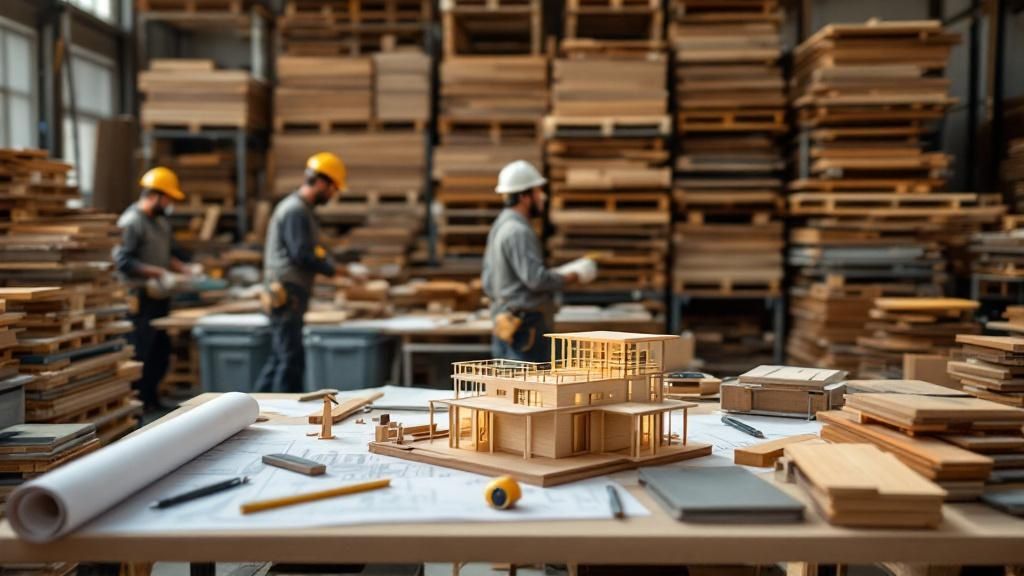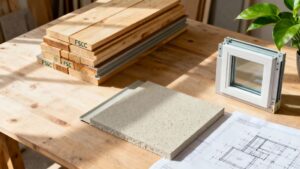Construction sites are major contributors to landfill volume, but this doesn't have to be the case. Proactive waste management is no longer just an environmental ideal; it's a critical business strategy that impacts your bottom line, enhances your brand reputation, and meets the growing demand for sustainable building in the Bay Area and beyond. Implementing effective methods for reducing construction waste directly translates to lower disposal fees, optimized material purchasing, and more efficient project timelines.
This guide moves beyond generic advice to provide a roundup of specific, actionable strategies tailored for today's building professionals. You will learn how to integrate waste reduction into every phase of your project, from initial design to final deconstruction. We will explore practical techniques like designing for disassembly, leveraging prefabrication, and implementing just-in-time material delivery to minimize excess. Each point is designed to offer a clear path toward a leaner, more profitable, and environmentally responsible construction process for builders, contractors, and architects in Berkeley, Oakland, and across Northern California.
1. Design for Disassembly (DfD): Building for the Future
What is Design for Disassembly?
Design for Disassembly (DfD) is a forward-thinking design philosophy that treats a building not as a single, disposable object, but as a collection of valuable components. The core idea is to create structures that can be easily taken apart at the end of their service life, ensuring materials are recovered for reuse or high-value recycling. This approach drastically reduces construction waste and preserves the embodied carbon within those materials.
This method requires a shift in how architects and contractors in the Bay Area approach connections and material selection. Instead of permanent adhesives and welds, the focus is on reversible fasteners and modular components. The goal is to create a building that functions as a "material bank" for the future.
How to Implement Design for Disassembly
Successfully applying DfD involves careful planning and precise execution. Builders and architects should collaborate early to integrate these principles into the project's DNA.
- Prioritize Mechanical Fasteners: Opt for bolts, screws, and clips instead of permanent adhesives, welds, or poured-in-place concrete connections. This makes separating elements clean and efficient.
- Design with Standard Dimensions: Using standard-sized materials and modular components simplifies both construction and future disassembly. This approach streamlines material sourcing and minimizes off-cuts.
- Keep Materials Separate: Avoid creating composite materials where different elements are permanently fused and difficult to separate. Design a facade so that the insulation, cladding, and structural frame can be individually removed.
- Create a Material Passport: Document every component, its composition, and its connection method in a digital "material passport." This provides future deconstruction crews with a clear roadmap.
Caption: Infographic illustrating the core principles of Design for Disassembly (DfD), including high material recovery rates, reversible connections, and digital tracking to create a circular construction economy.
As the data shows, the combination of high material recovery rates, reversible connections, and meticulous digital tracking forms the foundation of a successful DfD project. This structured approach not only prevents landfill waste but also adds long-term value to the building's assets.
2. Prefabrication and Modular Construction: Building Smarter in the Factory
What is Prefabrication?
Prefabrication and modular construction involve manufacturing building components or entire modules in a controlled factory environment before transporting them to the site for assembly. By moving the majority of the build process off-site, it achieves unparalleled precision and quality control. This systematic production is a powerful strategy for reducing construction waste, often cutting material overages by more than 75%, according to the Modular Building Institute.
The core advantage lies in factory efficiency. Unlike an unpredictable job site in San Francisco or Oakland, a factory floor operates on lean manufacturing principles. Materials are ordered in exact quantities, cuts are computer-guided, and any scraps are immediately channeled into an established recycling system.
Caption: Modular building components, constructed off-site with minimal waste, being assembled at a Bay Area construction site, showcasing the efficiency of prefabrication.
How to Implement Prefabrication and Modular Construction
Adopting a prefabrication model requires seamless integration between the design, manufacturing, and on-site assembly teams.
- Integrate Lean Manufacturing Principles: Apply concepts like just-in-time delivery and waste elimination within the factory. This minimizes material storage and prevents overproduction.
- Utilize Building Information Modeling (BIM): Employ BIM software to create a precise digital twin of every component. This allows for exact material quantification and streamlined data transfer to factory machinery.
- Establish Robust Factory Recycling: Create dedicated streams within the facility for every type of waste, from drywall off-cuts to metal scraps.
- Foster Close Collaboration: Ensure architects, engineers, and factory managers work in a tightly integrated loop to translate design intent into manufacturable components without generating excess waste. For detailed insights on the essential tools that power modern construction, explore our in-depth equipment spotlight.
This method transforms the traditional building site into a final assembly point, accelerating project timelines and drastically improving material efficiency.
3. Building Information Modeling (BIM): Digitally Reducing Waste
How BIM Prevents Construction Waste
Building Information Modeling (BIM) is a transformative digital process that creates intelligent 3D models of a project. More than just a visual, these models contain data about every component, from material specifications to quantities. This technology allows teams to virtually construct a building before breaking ground, identifying potential issues and optimizing material use in a digital environment.
This data-rich approach moves projects away from reactive problem-solving and toward proactive planning. It enables precise quantity takeoffs, minimizes ordering errors, and coordinates trades to prevent costly rework, making it one of the most powerful tools for reducing construction waste before it's ever generated. The digital model acts as a single source of truth for all stakeholders, from architects in Berkeley to subcontractors in Oakland.
Caption: A detailed BIM 3D model allows for clash detection and precise material quantification, preventing waste before construction begins.
How to Implement BIM for Waste Reduction
Integrating BIM effectively requires a commitment to digital workflows and collaboration across the entire project lifecycle.
- Establish Clear BIM Standards: Create a BIM Execution Plan (BEP) that defines roles, protocols, and data requirements to ensure all teams contribute to the model consistently.
- Use Clash Detection Early: Run automated clash detection reports regularly. This identifies where systems (like plumbing and structural elements) interfere, allowing for design adjustments before materials are ordered.
- Integrate with Procurement: Connect the model's material data directly to your procurement systems. This enables just-in-time material delivery, preventing over-ordering.
- Invest in Comprehensive Training: Ensure all team members are proficient in using the chosen BIM platform to leverage its full potential for reducing construction waste.
By adopting BIM, contractors can transform their planning process, turning digital precision into tangible waste reduction and cost savings on projects throughout the Bay Area.
4. Material Recovery and Recycling Programs: Turning Waste into Resources
What are Material Recovery Programs?
Material Recovery and Recycling Programs are systematic approaches to collecting, sorting, and reintroducing construction materials back into the supply chain. Instead of viewing leftover materials as trash, these initiatives treat them as assets. This creates closed-loop systems where waste from one project becomes valuable input for another, significantly reducing construction waste.
This method requires a proactive strategy for waste management on every job site. Instead of a single dumpster, the focus is on segregated bins and clear protocols. By diverting materials like wood, metal, and concrete from landfills, contractors can meet local regulations, like those overseen by CalRecycle, and capture the economic value of these resources.
How to Implement a Material Recovery Program
A successful program is built on planning, training, and documentation. It integrates waste management into the project from the beginning.
- Establish Clear Sorting Protocols: Designate separate, clearly labeled bins for different material types (e.g., clean wood, scrap metal, concrete). Train the entire on-site crew on what goes where to prevent cross-contamination.
- Identify Local Recycling Facilities Early: Before the project begins, research and connect with local Bay Area recycling centers and material brokers. Understand their acceptance criteria and potential rebates. You can discover more about sustainable innovations and local initiatives that support these efforts.
- Track and Document Waste Streams: Use a waste management plan to log the types and volumes of materials diverted from the landfill versus those disposed of. This data is crucial for reporting and demonstrating compliance with green building standards.
- Prioritize High-Value Materials: Focus recovery efforts on materials with higher recycling value or reuse potential, such as copper, aluminum, and clean dimensional lumber.
A structured approach to recovery is not just an environmental responsibility but a smart business practice for reducing construction waste.
5. Just-in-Time (JIT) Material Delivery: Optimizing Your Supply Chain
What is Just-in-Time Delivery?
Just-in-Time (JIT) material delivery is a lean supply chain strategy that coordinates deliveries to arrive precisely when they are needed for construction. This approach minimizes on-site material storage, directly tackling waste generated from damage, theft, or over-ordering. By synchronizing material flow with the project schedule, JIT turns the job site from a cluttered warehouse into an efficient, streamlined assembly area.
This precision is key to reducing construction waste, as it prevents the accumulation of excess materials that often get damaged or lost. For optimizing material flow and minimizing on-site waste, exploring how efficient Just-in-Time inventory systems operate can provide valuable insights for any construction project.
How to Implement Just-in-Time Material Delivery
A successful JIT strategy hinges on meticulous planning, communication, and reliable partnerships.
- Develop Strong Supplier Relationships: Work with trusted, reliable suppliers like Truitt & White who understand and can commit to precise delivery windows. A strong partnership is the foundation of JIT success.
- Leverage Digital Tracking Tools: Use construction management software to create and share real-time schedules, ensuring all stakeholders are perfectly aligned.
- Integrate with Project Scheduling: JIT must be woven into the master project schedule. The delivery of drywall, for example, should be timed to coincide exactly with when the framers are ready.
- Build in Contingency Plans: While precision is the goal, disruptions can happen. Create backup plans, such as identifying alternative local suppliers or having small buffer stocks for essential items.
For projects in dense urban areas like San Francisco, where space is at a premium, this approach is particularly effective. To learn more about how this integrates into a streamlined building process, you can explore the modern construction process in the San Francisco Bay Area.
6. Deconstruction: A Smart Alternative to Demolition
What is Deconstruction?
Deconstruction is a meticulous alternative to traditional demolition, treating a building as a source of valuable materials. Instead of wrecking balls, this method involves carefully dismantling a structure to salvage components for reuse or recycling. This approach is a powerful strategy for reducing construction waste and preserving the value of existing materials.
Caption: A skilled worker deconstructs a building in the Bay Area, carefully salvaging lumber for reuse in a future project.
This process turns a building's end-of-life into a resource recovery operation, creating skilled green jobs and diverting tons of material from landfills. It aligns perfectly with the principles of a circular economy and is often a key component in projects aiming for high sustainability ratings, such as those pursuing adaptive reuse architecture.
How to Implement Deconstruction
Successful deconstruction requires a strategic approach that begins long before the first wall comes down.
- Conduct a Pre-Demolition Audit: Before work begins, perform a thorough assessment to identify and inventory all salvageable materials. This includes hardwood flooring, old-growth timber, architectural fixtures, doors, and windows.
- Partner with Salvage Organizations: Collaborate with local Bay Area material reuse centers. These groups can assist with the deconstruction process and provide a market for salvaged goods.
- Invest in Proper Training and Tools: Deconstruction requires different skills and tools than demolition. Equip your crew with pry bars, nail pullers, and saws designed for careful removal.
- Plan the Deconstruction Sequence: Dismantle the building in the reverse order of its construction. This methodical process protects materials from damage and streamlines sorting.
By embracing deconstruction, contractors can unlock hidden value in old structures, significantly cut down on landfill fees, and build a reputation for environmental stewardship.
7. Standardization and Design Optimization: Designing Waste Out
What is Design Standardization?
Standardization and design optimization is a strategic approach that streamlines construction by using uniform dimensions and components. The principle is to design projects around commonly available material sizes, which dramatically minimizes the need for on-site cutting. By rationalizing design from the start, this strategy drastically reduces construction waste while improving material utilization.
This approach requires close collaboration between designers, suppliers, and builders to align plans with standard material dimensions. Instead of creating unique designs that require extensive customization and generate significant off-cuts, the focus shifts to creating efficient, repeatable systems. This not only minimizes waste but also accelerates project timelines.
How to Implement Standardization and Design Optimization
Successfully applying this strategy involves a proactive approach to both design and procurement.
- Design Around Material Sizes: Analyze the standard dimensions of common materials like plywood (4'x8' sheets), drywall, and lumber. Base room dimensions and layouts on these sizes to minimize cuts and waste.
- Develop Standard Details: Create a company-wide library of standard construction details. This ensures consistency across projects and reduces errors that lead to wasted materials.
- Coordinate with Suppliers: Engage with suppliers like Truitt & White early to understand their stock dimensions. Aligning your designs with their inventory can lead to better pricing and less waste.
- Embrace Modular Coordination: Use modular design principles where building components are dimensionally coordinated to fit together with minimal on-site alteration.
Advanced manufacturing techniques, such as those explored in the context of the sustainability and green aspects of 3D printing, can also greatly contribute to reducing construction waste through optimized designs and on-demand production.
Frequently Asked Questions (FAQs) About Reducing Construction Waste
1. What is the biggest source of construction waste on a typical project?
The largest source of waste is often drywall, followed by wood, concrete, and cardboard packaging. According to the EPA, construction and demolition (C&D) debris accounts for more than twice the amount of generated municipal solid waste in the U.S., making reduction efforts critical. Proper planning and material sorting can significantly cut down on this volume.
2. Can reducing construction waste actually save my project money?
Absolutely. Reducing waste saves money in multiple ways: lower disposal and landfill fees, reduced costs from purchasing fewer materials, and potential revenue or tax benefits from selling or donating salvaged items. Efficient practices like JIT delivery also reduce labor costs associated with material handling and site cleanup.
3. Are there specific Bay Area regulations I need to be aware of?
Yes, many municipalities in the Bay Area have stringent C&D debris recycling ordinances. For example, the California Green Building Standards Code (CALGreen) requires projects to divert at least 65% of their construction waste from landfills. Always check with the local city or county building department for specific requirements.
4. What's the first step a smaller contractor can take to reduce waste?
Start with a simple site waste management plan. Designate separate, clearly labeled bins for key materials like clean wood, metal, and cardboard. This small organizational step, combined with crew training, can make a significant and immediate impact on your waste diversion rates.
5. How does using a local lumberyard like Truitt & White help reduce waste?
Partnering with a local, knowledgeable supplier like Truitt & White helps reduce waste through precise ordering, reliable Just-in-Time delivery, and access to high-quality materials that minimize defects and damage. Our team can help you source standard-sized materials and provide expert advice on sustainable options tailored to Bay Area building codes.
Final Thoughts
Transitioning to a more resource-conscious model is a critical business strategy for builders in Northern California. The journey toward a zero-waste job site is built on intentional planning, technological adoption, and a shift in how we view building materials. The strategies covered—from designing for disassembly to embracing just-in-time delivery—represent an interconnected ecosystem of efficiency.
Your Key Takeaways for Immediate Impact
To embed these principles into your operations, focus on these core takeaways:
- Planning is Paramount: The most significant opportunities for reducing construction waste occur long before your team breaks ground.
- Technology is Your Ally: Modern tools like BIM are indispensable for forecasting material needs and streamlining procurement.
- Every Material Has a Future: Shift your mindset from "demolition" to "deconstruction" to see every component as a potential resource.
- Collaboration is Key: Effective waste reduction requires buy-in from everyone involved, including architects, suppliers, and subcontractors.
By integrating these strategies, you are not just cutting down on disposal fees. You are enhancing project profitability, strengthening your brand reputation, and contributing to a more sustainable building industry in the Bay Area.
Ready to put these principles into practice with high-quality, precisely ordered materials? Partner with Truitt & White. We provide the premium building supplies, expert support, and reliable logistics you need to minimize waste and maximize efficiency on every project. Visit our Berkeley showroom for expert advice or explore our products online at Truittandwhite.com.









